Internal Gearing for Winter
Tagged: bike diy project winterLast year I survived my first winter as a cyclist. This winter, I planned to do much the same thing - throw my leftover chain and brake pads on my old Huffy frame and wear it down over the winter, and then rebuild all my bikes in spring and return to easy, fairweather cycling. Winter, of course, had other plans for me.
Part 1 - The Windfall
This year, in late October, opportunity struck. I was at my local bike co-op and I noticed they had a huge number of red Linus cruiser bikes. They looked like Roadster Sport Models, albeit old ones. Apparently a local bike share program shut down a few years back, and these were the bikes that had been recovered. They had been ill-maintained, and looked like they had been in the weather a while, but they had all been donated, and the bike co-op was in the process of cleaning them up for sale.
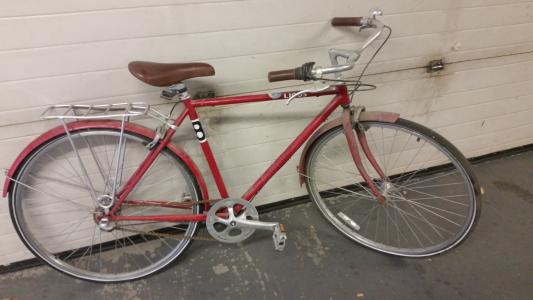
I asked if I could buy one of the un-restored ones for cheap. They told me it’d be about $50. So of course I walked home with one. (There were also some ladies bikes with a step through frame and a chain guard, the last of which sadly got wheeled into the shop before I made my decision.)
The reason I bought it was because ever since last winter, I had been toying with the idea of buying an internally geared hub so that I could have gears when winter riding without having a derailleur that would fail on me. The major roadblock was that new internally geared hubs tended to run upwards of $200, and that’s not even including the cost and time investment of me building a wheel around them. But then, here was a 700C wheel with an internally geared hub (A 3-speed Shimano Nexus!) ready to go, for the low price of $50. Plus, it even had a bike thrown in as a bonus! I figured I could steal the rear wheel and hub, convert the bike to use a derailleur, and give it to one of my friends.
Part 2 - The Build
Now, I did ask the guy who had been working on fixing up the Linus bikes what the over-locknut distance was. He told me they were standard 135mm rear hubs. That matched the rear spacing of my Huffy frame just fine, so I figured everything would be okay.
This turned out to be false. I haven’t done an accurate measurement of the rear hub (I don’t have the proper tools) but I would guess it’s 114mm, just guessing from Sheldon Brown’s Frame Spacing Page and eyeballing it.
Well, I figured, that’s not a big deal. The Linus frame was steel, so it wouldn’t be a problem to widen it a bit. Plus, I had some spacers I could put on the axle to let it sit in a larger set of dropouts. The axles themselves seemed to be wide enough to sit in the dropouts either way. So I got to work.
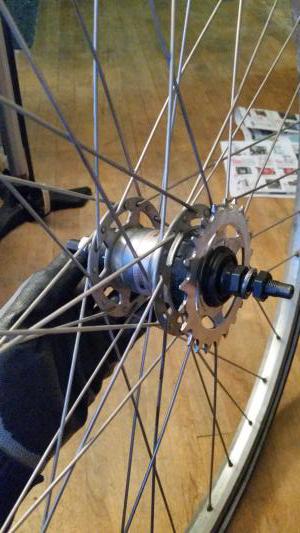
My winter frame is aluminum, so maybe it wasn’t the best idea. But I did get those spacers on underneath the locknuts, and I did install that wheel in dropouts that were way to big. I had to squeeze the frame a bit to do so.
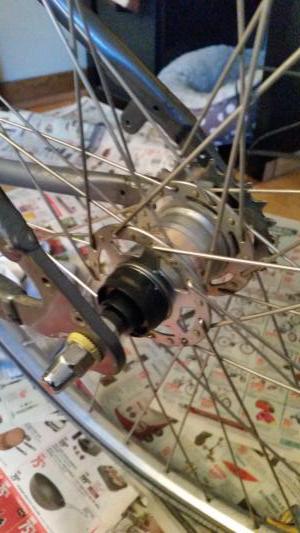
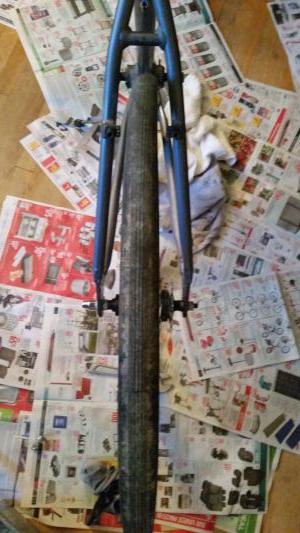
I threw the Linus bike in my garden shed, sans wheel, without a second thought. That would be a spring project.
The build continued on as before. I trimmed the chain I had been riding with since spring down to size and installed it. I moved my old V-brake pads over as well, in hopes that they would last the whole of the winter. A helpful trick is to take a dime or other small coin and press it between the brake pad and the wheel, so your brakes are properly toed and won’t squeal.
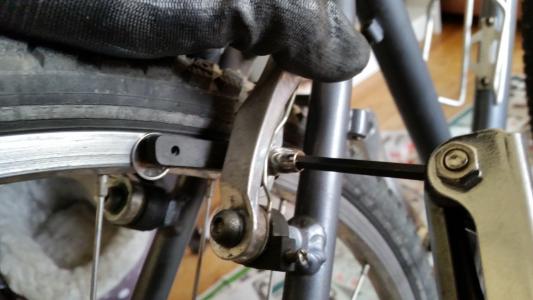
Then I learned that you can’t just widen the axle on an internally geared hub and expect the shifting to work smoothly. The gears of a Shimano Nexus hub are changed with a push rod.
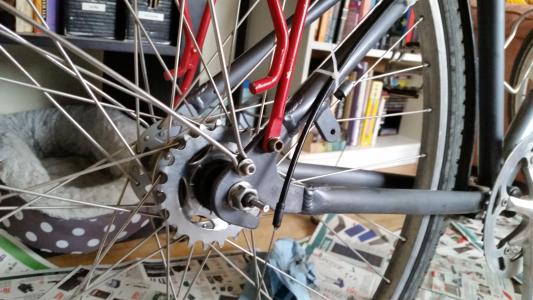
With an extra spacer on the axle and a wider set of rear dropouts, the pushrod protrudes a lot less than it should from the axle. This means that the shifter (which internally turns a cable pull into lateral force by pulling on a small lever) is no longer calibrated for quite the right amount of push-distance. (I’m not an expert on these things, but I don’t think the cable-pull-to-lever-push ends up being exactly linear.)
This wasn’t a dealbreaker either - as long as I could calibrate the shifter so that when it was in second gear, so was the hub, any less tension would leave it in first gear, and more tension would take it into third gear.

I also swapped out the stem for a quill stem that’s fully adjustable. I turned it pretty far upright because I’m very tall, but the ergonomics are still a little dicey. The frame of this bike technically isn’t big enough for me.
In the end, it was a little finnicky, and the result was that third gear occasionally slipped back into second. I was still able to get around, but it was less than ideal.
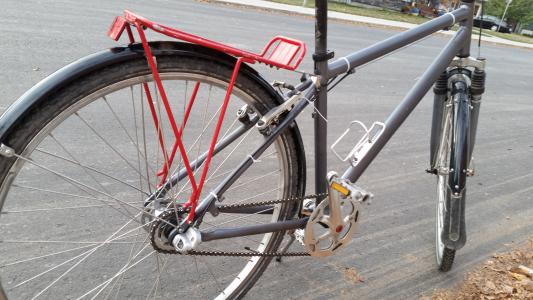
I re-used the cable housing for the shifter from the Linus bike, since it was all one cable. It was easy enough to secure it to the frame using zip ties, but next time I do this, I’ll make sure to be careful with how I trim it - at one point I cut my hand on a zip tie when it was particularly cold and I was leaning over my bike to unlock it.
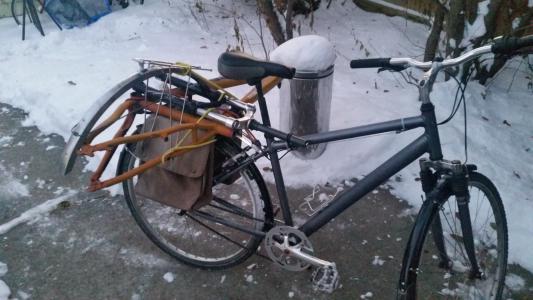
The only other issue with the internally geared hub was that it badly needed service. Walking the bike, there was enough friction in the hub’s ratcheting mechanism that it would push the pedals forward rather than coast. I can’t imagine how much energy I ended up wasting by coasting on that bike, I bet it was like I was lightly braking the whole time.
But I was more annoyed by the fact that I couldn’t walk my bike without it banging my shins a bunch. It was like walking a fixed gear bike through snowdrifts and incredibly narrow sidewalks. Not ideal.
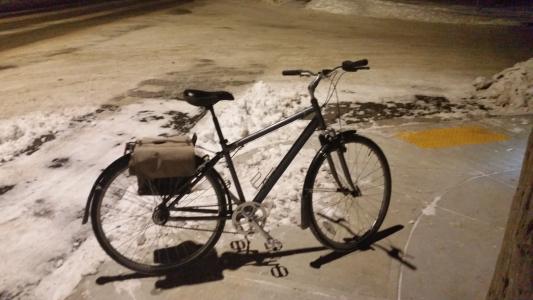
The bike was built, and was reasonably functional. Now it was time for some easy, unremarkable winter cycling.
Part 3 - A difficult Winter
Initially I was excited for winter - this time I had gears, so I could tackle more hills and go faster on the flats. What’s more, now I was regularly cycling into work, and my workplace has a heated parkade. Unlike last year, this year I was finally going to be able to regularly defrost my bike and perform maintenance.
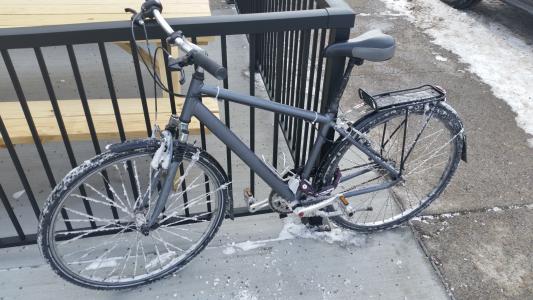
Sadly, this winter turned out to be an extremely warm, wet, salty, and slushy affair. It started in late november with huge dumps of snow followed by extremely cold temperatures. We had a few periods of deep freeze (In December it hit -40°C!) but after that, it was generally warm and wet. Half of my commutes were over slush or through deep puddles, while the other half were proper bumpy snowy frozen affairs. To combat the ice, the city started dumping a ton of salt onto roads and bike paths. I’d ride through piles of it. Sometimes there was enough of it that it behaved like gravel, and you could skid on it if you weren’t careful.
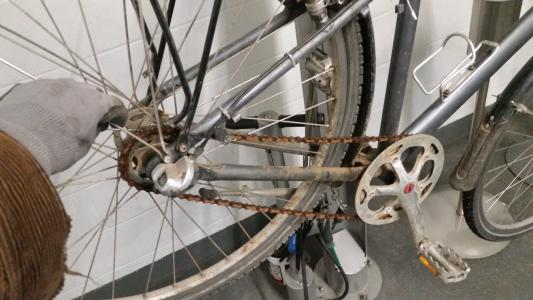
The result was that my bike decayed at an absolutely unprecedented rate. It wasn’t long before my brake pads were entirely worn out and couldn’t reliably stop my bike any more. And my chain almost immediately became caked in rust. By mid December, my bike looked about as bad as it did at the end of last winter. I continued to wipe it down and lube it, because I just wanted it to last until spring. I don’t like doing a ton of maintenance if the end result is that I’m going to take apart the bike. I don’t want to replace a chain in January or February so that it can start its life caked in salty road slush.
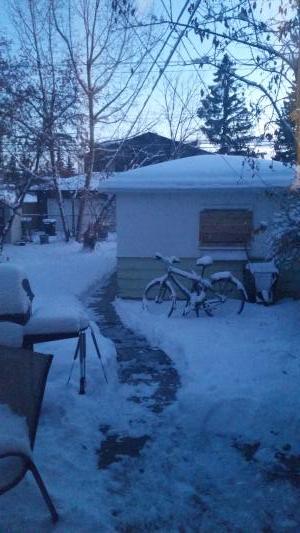
My leather mitts also began to fail me around this time. I’d been using them nonstop on the bike, and they were already old to begin with. The leather was worn thin, and was starting to show holes where I grip the handlebars. This made the gloves bitterly cold, in a way they weren’t last year. My way of mitigating this was to double layer with knit gloves, and to use disposable hand warmers. I’ll probably need a new pair for next year.

Part 4 - The Damage and Unwanted Maintenance
Towards the end of the winter, my bike was in rough shape. I thought the chain looked bad last spring, but by February it was so caked in rust that I could feel the resistance when peddling. It felt like every ride it got absolutely soaked. Over the course of a few months, it also stretched out quite terribly, to the point where it started to frequently fall off the sprockets. I tightened up the chain by re-seating the rear wheel a couple times, but it always worked its way back to having a lot of slack.
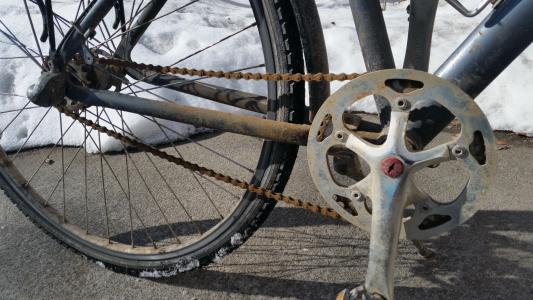
The brakes were also wearing down again - even after I had already replaced them once! I decided against replacing them a second time. Instead I re-seated and re-toed them. One of the rear brake levers had also completely seized, and constantly rubbed against the back wheel. It was so stuck that I needed a pry-bar to get it off. I cleaned it up, re-greased it, and tightened the spring as much as I could. After this winter it would surely be garbage.
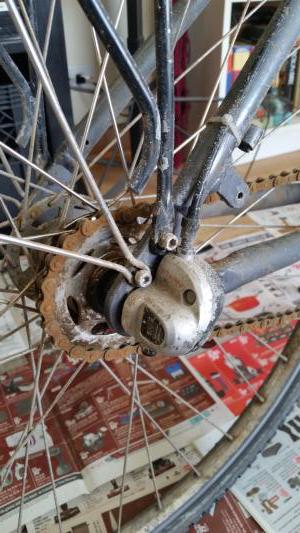
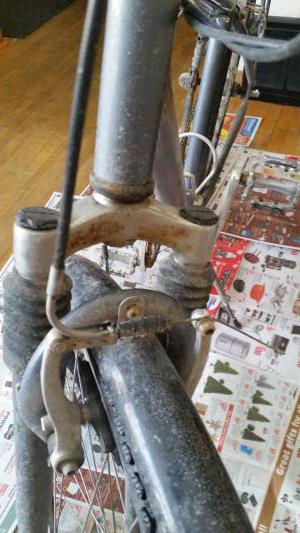
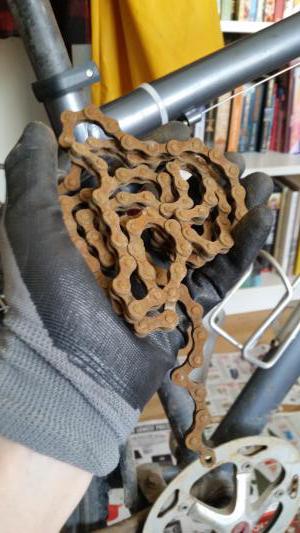

The inside of the shifter mechanism for the internal hub was quite clean! I had covered the openings with electrical tape from the inside to keep moisture and road grit out, and it looked like that worked quite well. Credit where credit is due - it kept working all this time.
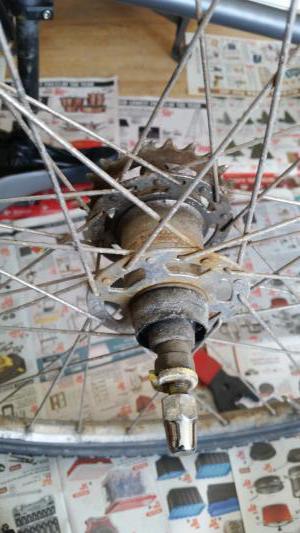
But at this point I was so sick of the added friction in the hub, and the dodgy third gear, and the fact that I occasionally had to grip the shifter tightly so that it wouldn’t slip out of gear, that I decided to hell with it, I was just going back to running a single speed. Nothing beats the mechanical simplicity of single speed.
Plus it would be nice to go back to a quick release rear axle. That would make it a lot less painful to tighten up the chain if it got loose again.
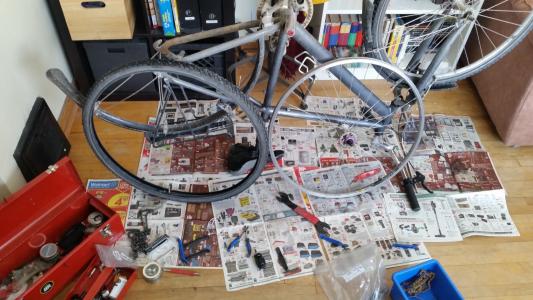
Speaking of the chain, I also dug through my parts bin and found an old chain that came off a trash bike. It was sized for a derailleur so it had enough slack that I was able to trim it down and re-use the old master link. Still feels like a bit of a waste, but at least I wasn’t breaking out a new chain for the last couple weeks of winter.
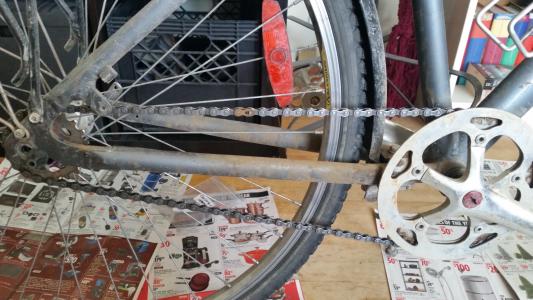
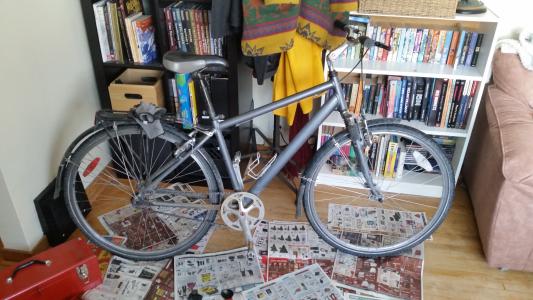
The other thing I was procrastinating on was inflating the tires. At one point over the winter I inflated my tires to max recommended pressure, and the next time I took the bike into the office, the tire bead came off the rim. I had to let the air out, re-seat the tire, and then walk my bike over to a nearby mall where an e-bike shop kindly inflated me to minimum pressure. Then I just let it sit like that for another month. I finally got them back up to optimal pressure, and the difference was immense.
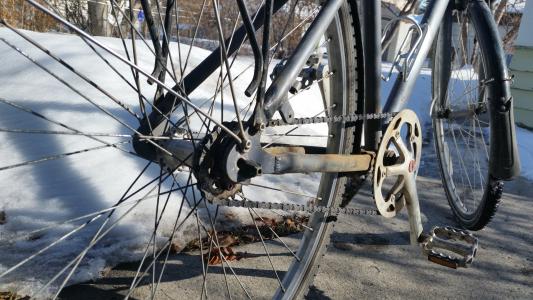
And to this day, I’ve been riding this bike. It’s still a little rough, but at least my life isn’t in danger due to faulty brakes, and I’m not being frustrated by a stiff rear hub or gears that slip.
I can still climb hills, albeit more slowly. For the largest hill on my commute, I rarely rode up it even with the lower gearing. Going back to a single speed has been much nicer, and though I miss the lower gearing sometimes, the simplicity of a single speed has won me over. For now, at least.
Lessons Learned, and Resolutions for Next Year
Next year I have a few goals:
- Carry a camera and photograph all the different types of urban winter terrain I encounter. I’d like to make a field guide to riding on bad winter terrain.
- Sew my own mittens, out of scrap leather and/or duffel. I’d like them to have rings that I can use to either clip them to my backpack, or tie them on a string threaded through my sleeves.
- Be more proactive on maintenance. Ruining brand new brake pads with winter road grit feels terrible, but my safety is worth $5
- Either run an internally geared hub that properly fits, or go back to single speed.
- Hopefully get a better frame for winter riding. This one is a little bit small for me, and I’m starting to feel it in my lower back.
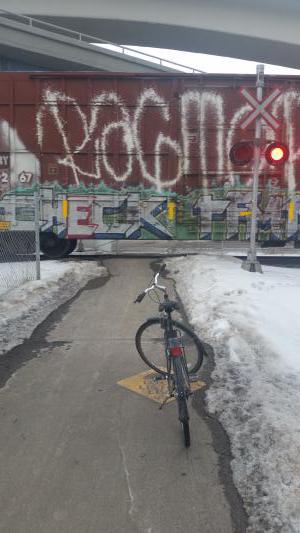
That’s all for now! Soon I’ll be putting my regular fleet back together and riding across dry pavement, and then I can take a break from freezing my fingers.